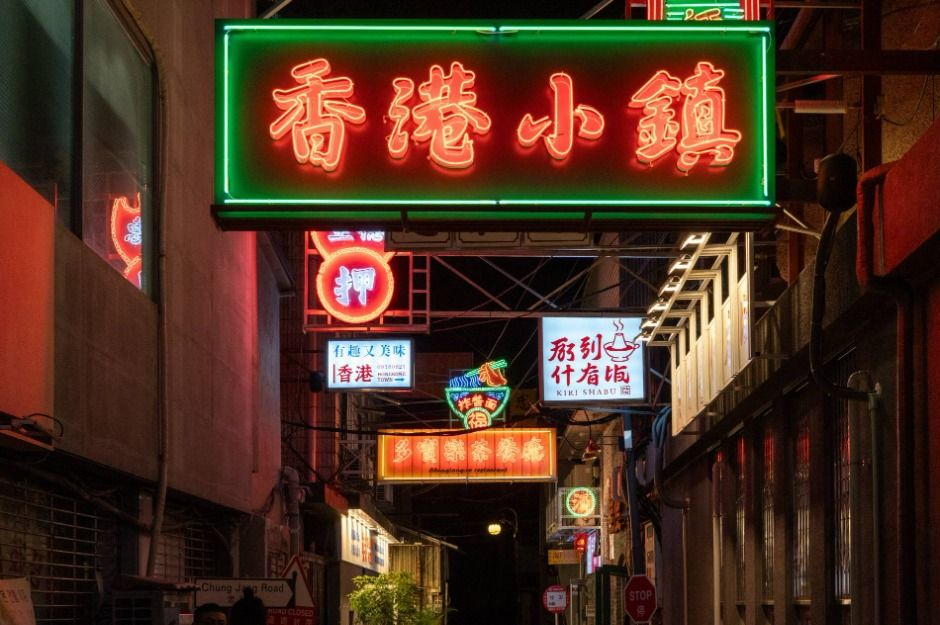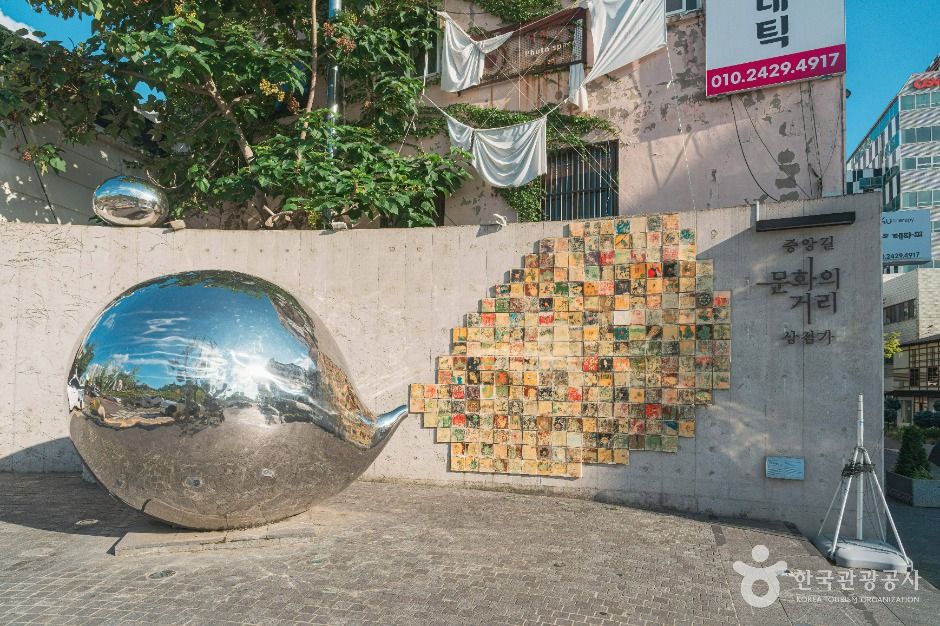Chungjang-ro Hong Kong Alley (충장로 홍콩골목)
2025-10-30
5-2 Chungjangnoan-gil, Dong-gu, Gwangju
Hong Kong Alley is a themed street located in the heart of Chungjang-ro, Gwangju. Stepping in feels like walking through the night streets of Hong Kong in a movie. With Hong Kong-style food, illuminated streets, and Hong Kong-style music playing softly in the background, it is a must-visit nighttime attraction in Gwangju.
Ulsan Culture Street (울산 문화의거리)
2025-10-23
Seongnam-dong, Jung-gu, Ulsan
Ulsan Culture Street is a 1,000-meter-long art street with various galleries, small theaters, cafes, and restaurants. The original city center, which was the center of Ulsan's economic development, has been transformed into an Art Street and a hub for local artists by infusing culture into it, and it is a place where artists can freely create, exhibit and sell their works, just like Montmartre Hill in Paris. There are many art-related attractions, making it a must-see destination for tourists. Every weekend, there are various cultural events such as an art fair, busking performances, street exhibitions, and concerts, where artists and citizens can communicate directly.
HM International Korean Medicine Clinic (하늘마음한의원 서초강남점)
2025-10-23
2nd Floor, Seokjeong Building, 96 Banpo-daero, Seocho-gu, Seoul,
Hanulmaum Korean Medicine Clinic is an institution that has been specializing in the treatment of various skin diseases, including psoriasis, atopic dermatitis, and seborrheic dermatitis, for 35 years. The clinic aims for personalized treatment that considers an individual's constitution and symptoms.
Treatment methods include herbal medicine to boost internal immunity, acupuncture to assist with blood and energy circulation, and topical agents to alleviate skin inflammation. Haneulmaeum Clinic emphasizes an integrated approach that simultaneously treats both the internal and external root causes of skin diseases. Furthermore, it provides education and counseling to help patients improve their lifestyle habits.
The Body Plastic Surgery Clinic (더바디성형외과의원)
2025-10-23
4th-7th Floors, 51 Seomyeon-ro, Busanjin-gu, Busan
THE BODY PLASTIC SURGERY
The Beginning of Beauty,
The Body Plastic Surgery
Since our opening in 2010, we have maintained a strict policy of no ghost surgeries—our dedicated medical staff personally performs every step, from consultation to the final stitch.
Our board-certified plastic surgeons, each with over 20 years of experience and expertise, focus on enhancing every client’s unique features. We emphasize overall balance to create natural, harmonious, and healthy beauty.
“We promise better service, highly satisfying surgical outcomes, and responsible post-operative care.”
Chung-Ang University Gwangmyeong Hospital (중앙대학교광명병원)
2025-10-23
110 Deokan-ro (Iljik-dong), Gwangmyeong-si, Gyeonggi-do
Chung-Ang University Gwangmyeong Hospital is a general medical institution with approximately 700 beds. Opened in March 2022, the hospital has a total floor area of 97,000㎡ and consists of 14 floors above ground and 8 floors underground.
The hospital operates around six specialized clusters for critical care: Cancer Hospital, Cardiovascular & Cerebrovascular Hospital, Respiratory & Allergy Center, Digestive Disease Center, Spine Center, and Joint Center. With leading specialists in each field and state-of-the-art medical equipment, it provides advanced treatments and multidisciplinary care.
Recognized as a “hospital specializing in surgery,” Chung-Ang University Gwangmyeong Hospital plays a central role in the metropolitan critical care system. It leads the digital transformation of healthcare by harmonizing digital healthcare with public health services, strengthening its position as a highly competitive medical institution. Moving forward, the hospital will continue to pursue patient-centered medical innovation and strive to become a next-generation hospital that represents not only the Seoul metropolitan area but also the Republic of Korea.
Hanyang University Seoul Hospital (한양대학교병원(서울))
2025-10-23
222-1 Wangsimni-ro, Seongdong-gu, Seoul
Hanyang University Medical Center, established in 1972 with the motto of "Love in Deed and Truth", offers exceptional medical care to patients worldwide. It is equipped with advanced medical equipment and staffed by highly skilled and experienced medical professionals. The hospital has achieved grade 1 in the adequacy evaluation for several diseases, including cardiovascular and cerebrovascular diseases, as well as major cancers, making it a top medical institution. Its goal is to provide prompt and convenient medical care to both domestic and international patients in a patient-centered approach.
Good Moonhwa Hospital (좋은문화병원)
2025-10-23
119 Beomil-ro, Dong-gu, Busan
Good Moonhwa Hospital is a general hospital that has been in operation since 1978. It has 22 departments and 23 specialized medical centers, including a Gynecologic Cancer Center, an Infertility Center, a Natural Childbirth Center, a Neonatal Intensive Care Center, a Gastroenterology Endoscopy Center, an Artificial Heart Center, and a Breast & Thyroid Center.
Healingeye Clinic (힐링안과의원)
2025-10-23
10th-11th Floors, 808 Tower, 470 Gangnam-daero, Gangnam-gu, Seoul
With advanced medical equipment and extensive experience, we provide vision correction surgery—including LASIK, LASEK, and cataract surgery—for patients whose vision has declined.
Through our 1:1 dedicated doctor system and our lifetime surgical responsibility guarantee, we ensure lifelong care for your eyes.
At Healing Eye Clinic, we pursue a haute-couture approach to medical service, offering a premium, personalized vision correction program that is tailored to each individual.
With us, you can discover clearer, sharper vision.
JAYJUN Plastic Surgery & Aesthetic (제이준성형외과)
2025-10-23
667 Yeoksam-dong, Gangnam-gu, Seoul
JAYJUN Plastic Surgery consists of board-certified plastic surgeons and experienced medical staff. All procedures follow strict safety standards and medical regulations. The clinic is equipped with advanced medical devices and maintains rigorous hygiene protocols, prioritizing patient safety and care.
Chonnam National University Hwasun Hospital (화순전남대학교병원)
2025-10-23
B1 Floor, International Medical Center, 322 Seoyang-ro, Hwasun-eup, Hwasun-gun, Jeollanam-do
Chonnam National University Hwasun Hospital (CNUHH) is a globally recognized cancer-specialized hospital, selected one of the “World’s Best Specialized Hospitals” in the oncology field for five consecutive years by Newsweek. Within ten years of its opening, the hospital achieved the highest number of cancer surgeries nationwide, received JCI accreditation twice, and has become a global hospital visited by hospitals in the metropolitan area for benchmarking. The hospital has consistently received top grades in the National Quality Assessment Program by the Health Insurance Review and Assessment Service, demonstrating its excellent medial services. In 2011, the hospital opened the “International Medical Center” to attract foreign patients and pioneering overseas medical markets, and expand it global network. It is the only national university hospital in the nation to have acquired the “Korean Accreditation Program for Hospitals Serving Foreign Patients (KAHF)” by the Ministry of Health and Welfare three times.



 English
English
 한국어
한국어 日本語
日本語 中文(简体)
中文(简体) Deutsch
Deutsch Français
Français Español
Español Русский
Русский